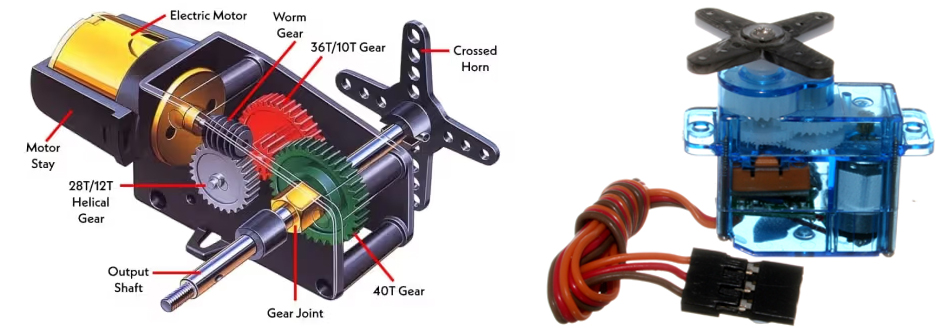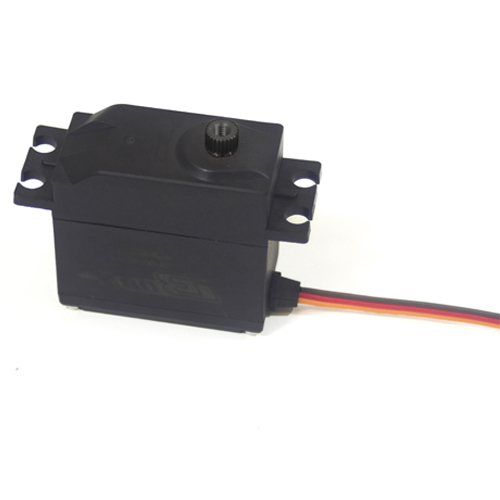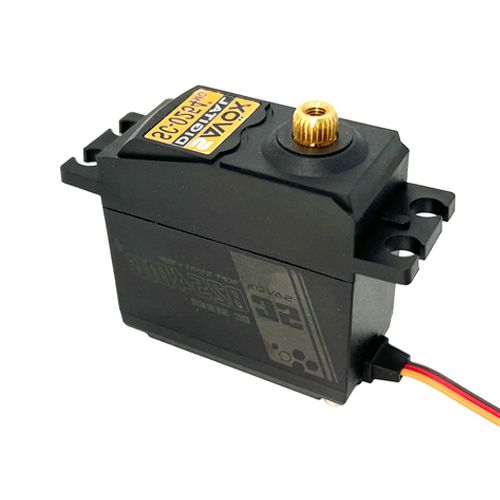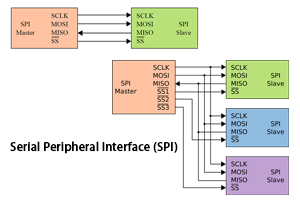Servos in Detail: Definition, Types, and How They Work
Author:admin Date: 2025-03-29 08:16 Views:159
Introduction
Servomechanisms or servos refer to different types of machines you might have already interacted with. You can expect to find such machines in robotics, vehicles, electronics, and industrial applications.
Basically, servos are motor-driven systems that feature a feedback mechanism built into them. The feedback mechanism allows for precise control of the machine to achieve a particular outcome.
Servos are likely to vary greatly depending on their size, type, design, and more. This guide explores more about servos to help better understand them. In addition to the definition, we also look at the types, components, how servos work, and more.
Core Components of Servos

Servo Motor Components and Micro Servo Motor
Servos might have additional parts depending on their use, but the core components are the same. Here is a quick look at the core components of servos.
Motor – This is the primary source of mechanical power for the servo. Its job is to convert the electrical energy supplied by the power source into mechanical motion to drive the servo to perform a specific task.
Control circuit – This is often referred to as the brain of the servo. Its job is to process the signals from the input and adjust the motor position. Each time you change the code on how the servo should react, that is translated by the control circuit.
Feedback mechanism – The feedback mechanism monitors the speed and position of the motor and relays the information to the control circuit for precise control. Examples of feedback mechanisms include potentiometers and encoders.
Potentiometers offer variable resistance, allowing you to adjust it accordingly. They are a simple feedback method. An encoder, on the other hand, is more complex. It is often used to adjust the motor’s position and speed.
Gearbox – Its job is to amplify the torque output of the servo’s motor. It also allows for precise movements.
Output Shaft—This is a rotating component that transmits the mechanical power from the servo’s motor to the application.
Housing – This is the casing that protects and integrates all the servo components. Some components may be delicate, thus the need for housing for additional support and protection.
Cooling system—Depending on the servo type and application, you may get some with cooling systems. A cooling system is vital for keeping the motor and other components from overheating, which affects overall performance and longevity.
Power supply—The servo motor needs a reliable power supply to provide the electricity needed to operate it. Depending on the type of servo motor, the power supply can be AC or DC.
Types of Servos
There are several types of servos in the market right now. They vary in terms of how they work and how they are powered. Let us look at them below to see which would be ideal for your project.
DC Servo Motors

This is the most common servo type in the market. It is powered by direct current and is known for its speed, accuracy, and responsiveness. Because of these features, these motors are common in robotics and CNC machines.
Expect to come across brushed and brushless DC servo motors.
The brushed DC servo motors have brushes and a commutators that provide for mechanical commutation. They are suitable for low-cost applications.
The brushless DC servo motors use electronic communication. As such, they offer better efficiency, smoother operation, and lower maintenance.
AC Servo Motors

This is an alternative to the DC servo motors. The difference is that they are powered by an alternating current. This makes them offer high power, low maintenance needs, and more accuracy.
The AC servo motors are preferred for applications that require precision and variability.
Rotary Servo Motors

These servos are designed to produce a rotational motion. They are further categorized as positional rotation servos and continuous rotation servos.
The positional rotation servos will rotate within a specific angle range. It is typically 180 degrees. They are designed to have stops to prevent over-rotation. This is for you if you have an application that needs specific angle rotation.
The continuous rotation servos will easily rotate continuously in any direction. So, if you have a project where continuous movement is necessary, this can be good for it. For example, they can be used to drive robot wheels or conveyor belts.
Linear Servo Motors
As the name suggests, these servos move in a straight line. They are useful for applications that need linear motion. For example, you can find them in actuators for industrial applications.
Analog Servos

Servos can also be categorized based on how they are controlled. Analog servos use analog signals, such as voltage, to control their position. These signals can be less precise and responsive than those of digital servos.
Digital Servos

Digital servos were invented to address the shortcomings of analog servos. For this reason, they use digital signals to control their position. They are expected to offer greater precision, responsiveness, and speed. Because of their control through digital signals, there are many more applications for digital servos.
How Servos Work
Several components must interact for the servo to work. These include the control signal, motor and gear mechanism, feedback system, and error correction.
The controller sends a pulse width modulation (PWM) signal to the servo’s motor, which tells the motor to move in a desired direction or position.
Once the motor intercepts the signal, it responds accordingly. The motor relies on the gearbox mechanism to control the output speed and movement to the desired position.
The feedback system is critical to the servo’s accuracy as it continually monitors how the motor moves, which is the expected output from the controller. The feedback system uses encoders or potentiometers.
The controller circuit uses the feedback system signal and compares it to the desired position it had sent to the motor. If there is an error, the controller will adjust the power to the motor to correct its position until the feedback signal matches the desired setpoint.
Applications of Servos
Servos generally have many applications. Expect to encounter them in many fields. Below, let’s see where you are likely to get servos.
– Industrial Automation
The robotics industry is widely known for using servo motors. This is because servos allow for precise movements. Robots use servos for applications such as welding, material handling, assembly, and painting.
Still, servos can be used in CNC machines under industrial automation. These machines require precise control for woodworking, metalworking, and many other manufacturing processes.
Machine tools such as lathes, grinders, and milling machines could also use servo motors. This would ensure precision since most of the products made with such machine tools have tight tolerances.
– Aerospace
Servos are also common in the aerospace industry. They can be used for aircraft control. This is through the movement of control surfaces such as elevators, rudders, and ailerons. As a result, you end up with precise control during a flight.
The servos are also good for antenna and telescope positioning. This leaves you with high accuracy.
– Consumer Electronics
These are probably the most common ways you interact with servos without knowing. For example, a remote-controlled toy will have servos for controlling its movement and changing direction.
Autofocus in cameras also uses servos to focus the lens while maintaining accuracy quickly. We also find servos in automatic door openers as well. It could be a hospital or supermarket entrance where you find such doors that automatically open as you approach.
Pros and Cons of Servos
Pros
- When using servo motors, expect high accuracy and precision. The feedback signal ensures precise control of velocity, position, and acceleration.
- Depending on the unit, you can get high-torque models. Since you can also change the power, this allows for using the servos in applications that need to move heavy loads at a variable speed.
- Thanks to the amplifier, servos have smooth torque control. It is now easy to adjust the torque depending on the application.
- The servos also offer high reliability. They may have to move a lot over the years of operation, but the best part is that if you get a good-quality servo, you do not need to worry about it breaking down.
- You may notice that servos are generally quiet, even at high speeds. As such, you can use them in applications where noise should be kept to a minimum.
- Small servos for general applications are affordable and readily available. You can get them in most electronics stores for your basic projects.
Cons
- Servo motors tend to be more expensive, especially if they are used for complex applications such as robotics, welding, and painting.
- Overloading the servo motor can lead to damage. Replacing a motor can be expensive if it is specialized for industrial applications.
Choosing The Right Servo For A Project
It is vital that you take the time to find the right servo for your project. We share a few tips to help you choose the right servo.
Torque Needs
Look at the project you want to handle and compare that to the torque you want in a servo. The torque makes the servo powerful enough to work on a project. For example, if you need to move heavy loads, enough torque is needed to start rolling the conveyor belt.
Speed Needs
Just like torque, speed is important. Speed is measured in revolutions per minute (RPM). It indicates how fast the servo will operate while still maintaining the right torque for the job.
Looking at a packaging machine as an example, here you need servos with high speeds without dropping their torque to keep up with the production demands.
The Power Density
It is vital to have a servo with good power density. This is the amount of power the servo can deliver in relation to its size. In the aerospace industry, most of the time, you are constricted to space; that is why you need a servo with high power density that will not take up a lot of space as well.
Servo motors used in portable equipment also need more power density to maintain their functionality and remain small enough for portability.
Reliability
It remains essential to have reliable servos for your application. The last thing you need are servos that keep breaking down. Look at the manufacturer’s reputation to see if they are known for delivering the best performance servos.
Besides the brand reputation, look at the value you get for the money. This will help you a lot in choosing the most reliable servo, even at times getting affordable units.
Maintenance Needs
How often is the servo supposed to be serviced? If so, what do you need to change?
These are some of the questions to ask yourself about maintenance before buying the servo motors. You should get one with a realistic maintenance schedule that does not necessarily affect the project.
Troubleshooting and Maintaining Servos
It is possible that you will run into issues while using servos. Understanding a few tips on how to troubleshoot and maintain servos can save you a lot of time. Here is what you can do.
Overheating Servo Motor
This is possible if the servo has been running for long periods and it is being overloaded. Also, a very high supply voltage greater than the stated maximum value can lead to this.
To resolve this, reduce the voltage supply to the recommended range. Also, check if the servo load is within the rated range.
Blow any clogged vents. The servo needs the vents to cool as it works on a project.
Servo Motor Not Running
You may notice the servo is not rotating as it should or does not even turn on, although you have checked that there is a power supply.
Start by checking that the fuse has not failed. Sometimes, that happens, and the motor will not turn on.
A bad connection can also prevent power from reaching the servo motor. Check all your connections to ensure they are in good standing.
Servo Motor Acceleration is Low
The main cause for this is when you have a low supply voltage. Also, you could be using incorrect servo controller settings.
You should measure and improve the supply voltage to ensure it matches the required range. Still, look at the controller’s settings to ensure it runs at the desired speed.
Tuning the servo controller can help keep the acceleration at the desired rate.
Conclusion
Servos remain important in many applications. It could be a simple remote-controlled toy car or a complex piece in a lathe or CNC machine. These are all important applications in which the working principle of servos becomes a reality. One thing you should always do is pick the right servo based on your project needs. Research comes in handy when deciding which servo works best for you. Also, follow any recommended maintenance schedules by the manufacturer to keep the servos in great working condition.



